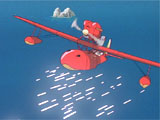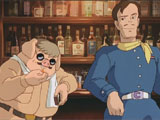

Quick Links:
Porco Rosso
With an astounding eighty confirmed kills throughout his career, the Baron Manfred Albrecht von Richthofen is the most celebrated pilot of the first World War. Dubbed The Red Baron by the English, they had painted red spots on the noses of their warplanes to signify their determination in shooting down his crimson Fokker Dr.I Dreidecker tri-plane. Though there's no proof of who fired the lethal shot, the Red Baron's career ended while chasing Wilfred May's Sopwith Camel deep into English territory. Even though his body was recovered by the English, he was buried with full military honors. Famed comic writer Charles Schultz often parodied the tale, with Snoopy's Sopwith Camel (which in actuality was his dog house) constantly getting shot down by the Red Baron. A similar tale exists in Japanese film - a bounty hunter and ace pilot flies the temperate Italian seas in his crimson seaplane, unstoppable by anyone - except possibly a hotshot American who wants to go up against the best. By the way, the ace pilot is a pig. That film is Porco Rosso (meaning Crimson Pig, in Italian), directed by Mr. Hayao Miyazaki. Charming, sophisticated, and hilarious, Porco Rosso brings the thrill of old airplanes to life.
Porco Rosso takes place in the late 20s. As it opens, Porco saves a group of children from a band of air pirates called the Mama Aiutos. After collecting handsomely for his heroics, he heads down to his friend Gina's bar - an establishment that welcomes anyone, pirate or not. There we meet Donald Curtis, an American pilot with a wickedly fast plane (a Curtiss R3C-0). He proposes to Gina on the spot, and she tells him kindly that she's married enough pilots, the last of whom just died. We also learn that Marco (Porco) was once a human, and flew in the Italian Air Force in the first World War. Curtis has come to Italy to defeat Porco in a dogfight, so he can truly say he's the best pilot. The plot of the film centers around this little rivalry.
Curtis is a braggart, and completely full of himself. It seems as though his only joy in life is putting on a show - and, amusingly enough, he's trying to use his popularity to get in with the Hollywood crowd. He's got the skill as a seaplane pilot to back up his boasts, though, and he is quite the challenge for Porco in the air.
By contrast, Porco is a loner, living on a secluded island with only his radio and plane to keep him company. Exactly how he became a pig is unclear, but he is clearly jaded about humanity in general - Gina and his mechanic being the only people he'll confide in. He's convinced that the good people are first to die, and has little hope for the world - especially considering the Italian Government's move toward fascism. (The Red Baron probably felt the same way going into that last battle, after all his friends were dead and his government was using him for propaganda.) He cracks jokes about how their ridiculous new laws don't apply to pigs, and this denial of his humanity is the primary theme of the film. The real turning point for Porco is when he must go to his mechanic in Milan for an overhaul, and he meets the mechanic's granddaughter - a cute redhead named Fio. Her innocence makes him start to think that maybe humanity isn't so bad after all. From start to finish, the story is well executed and is a lot of fun to watch.
In order for this movie to work, Porco's bright red plane had to seem as unstoppable as the Red Baron's Fokker. This was a job for Ghibli's animation experts, who pulled it off flawlessly. With the camera in motion as much as the planes, the film makes you feel like you're a part of the action. In addition to the frequent camera pans, the animation also featured the gorgeous background scenery often. Anyone who has seen the starry effect of a setting sun on the sea will recognize that this film captures it beautifully - and that's just a tip of the iceberg.
Porco Rosso's character designs carry a degree of amusement - and in the case of Gina, elegance. Porco himself is large and boisterous, with a big mouth - but he carries himself in a sophisticated manner, as if the civilized part of his human self never left. The mechanic looks and acts like an excited little boy, though he's an old man. Curtis definitely looks his part, with a lean build and square chin. The rest of the characters are generally humorous in appearance - an example being the leader of the Mama Aiutos, who looks like Bluto from the Popeye cartoons.
When the characters visit Gina's early in the movie, she greets them with a lovely song in French, titled Le Temps des Cerises (The Time of Cherries, sung by Tokiko Kato). The song is one of thinking back to good old days, and most of Porco Rosso's music carries the same romantic feel - though there is the occasional upbeat number. The ending song, Toki niha Mukashi no Hanashi wo (At times, speak of the old days), is also performed by Ms. Kato. She has a deep singing voice, and very elegant. Overall, Porco's music is pleasant and emotionally rich, if reserved.
Porco Rosso is my personal favorite of the films that Mr. Miyazaki has directed. It's great fun, and none of the film's more serious themes weigh it down needlessly. Adults should find many things to relate to (being that the majority of characters are older), and the flight scenes will keep the attention of the younger audience. This film lets you feel childish curiosity and the fondness of memories past all at once. Just don't relive that episode you had as a youngster that involved a public fountain, no clothing, and too much booze. Some things should remain in the past.
Distributor: Disney Creator: Hayao Miyazaki / Studio Ghibli Released: 1992
Plot: A- Character Design: B+ Animation Quality: A+ Music: A Overall: A



